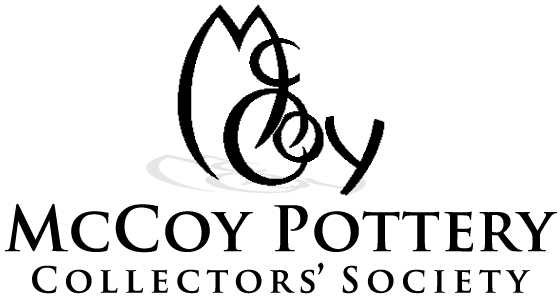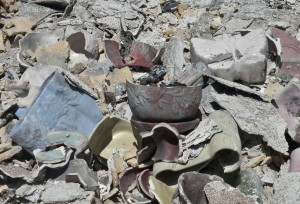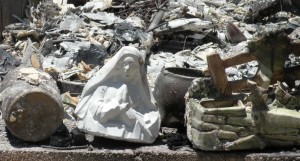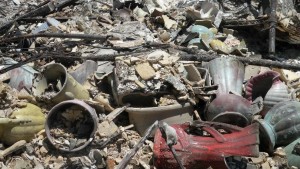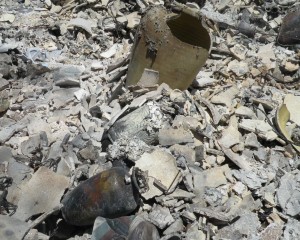THE JOURNAL JULY 2014
KNOW YOUR INSURANCE COVERAGE
BEFORE THIS HAPPENS TO YOU
By Dan Schroeder and Dorman Olson
On June 30th of last year, a wildfire hit our community in Yarnell, Arizona. The Wildfire was moving away from our community but then did a sudden 180 degree change of direction. Storm winds drove the fire back toward us at the rate of about 4 miles in less than an hour, leaving us and all our neighbors’ precious little time to evacuate. Some of us were able to grab a few personal items while many left with just the clothes on their backs. 19 brave firefighters lost their lives in the raging inferno and over 120 homes were reduced to nothing more than a pile of ash with very little recognizable. The heat alone was high enough to melt gold and suck the life out of 100 year old mature oak trees that were not in the direct path of the flames.
The loss of everything was difficult at best, but the loss of our antiques, pottery and artwork was devastating. Over 400 pieces of McCoy Pottery were lost, with but only a chance to save a few very special pieces when evacuating. With burning embers already falling on our home there just was not enough time to save more. Several pieces later found in the rubble appeared to be intact; only to have them fall apart the minute we picked them up. The heat from the fire was so intense that pieces felt 50% lighter in weight.
Several Leslie Cope paintings and etchings were also lost, most purchased directly from Velma Cope. Weller, Rookwood, Shawnee, Stangl, Kay Finch, Will-George and Borden’s Elsie the Cow pieces also were lost for a total of over 600 pieces.
We were fortunate to have had over 80% of our collection appraised a few years ago, with individual photos of each. Without the ability to get a copy from the appraiser after the fire we would have never been able to remember each and every piece in our collection.
There were also many pieces that were collected after the appraisal and required months of “remembering” to add them to our insurance claim. At the time of writing this article it’s been almost 10 months since the fire and we continue to work on submitting personal property inventories to the insurance company for reimbursement.
We hope that sharing these photos and our insurance experience with you will prompt you to thoroughly review your insurance coverage levels and claim procedures so please keep these following points in mind:
- You know more about your home and personal property than your insurance company so don’t expect them to properly value your home and personal property based on the limited information that they have. Typically, they first establish a replacement value for your home and then all other coverage’s are a percentage of that value. The problem is that many agents use software that asks very few questions about your home … and the results are an estimate only. If your house is underinsured, then your limits on personal property will be lower than they would be with proper insurance on the house.
- Don’t automatically accept the coverage limits proposed by your insurance company. Ask questions and challenge anything that just doesn’t seem right.
- The replacement value of any item includes not just its value, but also sales tax. In some areas this can add almost 10% to the cost to replace lost or damaged items.
- Find out what is automatically covered and to what level. Do you need additional insurance for “scheduled items”? There is often a dollar limit for any single item so it becomes crucial to know your policy details and make adjustments to arrive at proper insurance coverage’s.
- Finally, always remember that insurance companies are in the business of making profits for their stakeholders and may try to avoid paying out after a loss.
Our policy pays us a depreciated value for most personal property … then allows us up to two years to replace the items and then collect the difference between what they initially paid us and the actual cost of the replacement. The problem is that you simply cannot find exact replacements for this many pieces in a 2 year period … most people with significant collections have spent decades looking and buying. Talk to the insurance agent about getting coverage that pays full value for your collectibles up front … not a depreciated value.
We also feel there is a difference between some sale values versus the actual replacement cost of antiques and collectibles for insurance purposes. We all regularly see pieces sell at auction or online for often less than we paid, or certainly less than when the market was stronger. But we all also see the same pieces often priced higher than those online levels both at antique stores and online.
In an insurance claim the replacement value is what it would cost you to locate and buy that exact piece RIGHT NOW. It doesn’t matter if the exact piece sold last week on EBay for $25 … if you have to go to an antiques store and pay $75 to immediately replace that lost piece then that should become the replacement value. Our point is to not fall into the mindset that says the replacement value is what you THINK the value should be based on recent sales … it’s what you have to ultimately PAY, even when higher than expected.
Here are some random questions that may arise for some or possibly many collectors:
Do you have your Pottery Collection insured?
A: Unfortunately we have direct experience with dealing with a fire that destroyed our home and our McCoy Collection of several hundred pieces. We did have insurance coverage. If we did not have coverage, the value in the Pottery would have been a total loss. However, even with insurance, the challenges after the horrific event were certainly there. We had our Collection formally appraised several years prior to the fire including photos of each piece in the appraisal. This was a very important factor in working with the insurance company after the fact. Current values of the pieces and also estimating replacement costs with additional consideration for sales tax, travel, etc. were all topics that had to be reviewed in great detail but having the photos and original appraisal as a base point to start was indeed a critical ingredient.
So how do you determine the right person to do the appraisal?
A: We used an appraiser that also worked in the antiques and collectibles market for many years and that had access to all reference guides and other published information specific to our collection.
Are having photos of the individual pieces enough?
A: Every piece on our appraisal had an individual photo PLUS descriptive information that identified condition issues; reference book pages; value ranges; purchase invoices; etc. The appraiser used all of this information in determining the final valuations. Remember, the sharpness of the mold and quality of the glaze affects value so always add appropriate comments.
What if the pieces in the collection were photographed in groups instead of individually?
A: Photos of groups of pieces will never show the level of detail that a good close-up photo of an individual piece will. Don’t take any chances … spend the time and do a thorough piece by piece documentation of your collection!
If you had it all to do over; what different approaches might you have done?
A: Store information outside of your home … at your office, on “the cloud”, on a thumb drive in a safe deposit box, etc. AND KEEP IT CURRENT as your collection grows.
As a conclusion, what is the recommendation to Society members for insuring their collection?
A: KNOW YOUR POLICY. Know the coverage levels and the procedures you’ll need to follow for a claim, and know whether or not you should increase your limits or list specific pieces as “scheduled items”.
And don’t forget the rest of your personal property. Make it an annual event to take photos of absolutely everything in your home … open drawers, open closets and storerooms, open pantries … remember to photo every wall, every floor, everything. Otherwise in a loss you’ll never remember every throw rug, every pillow, every doily, and each and every measuring spoon.
